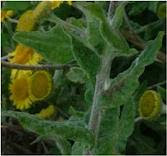This common fleabane is native to Europe and western Asia . It is a member of the daisy family or Asteraceae or Compositae family of plants, so if you are allergic to these, keep away from fleabane. As a member of this family it is related to pellitory or Roman chamomile, marigolds, purple goat’s beard (salsify), yellow goat’s beard, elecampane, the ox-eye daisy, holy thistles, costmary, tansy, feverfew, groundsel and yarrow, to name but a few of its relatives.
A botanical synonym for it is Inula dysenterica Linn., while it is also known in English as fleabane mullet. It can grow to heights of around two feet and it looks like a golden daisy. Pulix, the root of the name of the genus, is Latin for flea.
The leaves and roots of fleabane were used for dysentery, as the Latin name suggests as they have astringent properties. A paste made from the leaves has also been used for wounds and cuts, applied externally to heal them. The bruised leaves have a slightly soapy smell, and they were used in mediaeval times to repel fleas and other insects. The leaves were burned to rid a house of pests, hence the common name fleabane.
This is what the English herbalist Nicholas Culpeper, writing in the 17th century has to say about it:-
“Names: It is called also in English, mullet and in Latin conyza.
Government and virtues. It is hot and dry in the third degree. The herb being spread under foot and smoked in any place, will drive away venomous creatures- and will kill and destroy fleas and gnats. An ointment of the roots and leaves is used with success for the itch.”
He does not mention its use in dysentery as this was a continental remedy and the plant was not much used for medicine in Britain . There were other plants that were deemed efficacious for this.
Modern clinical trials have shown that extracts of the plant have antimicrobial and antibacterial properties against some bacteria. It is thought that the insect repelling properties of the plant are due to its thymol content, as this has proved to have the ability to kill houseflies. Interestingly it has also been discovered that plants from different countries have different bioflavonoids in them, some have kaempferol while others contain more quercetin and so on.
 There is another plant which Culpeper calls flea-wort which was used in medicine in
There is another plant which Culpeper calls flea-wort which was used in medicine in 




